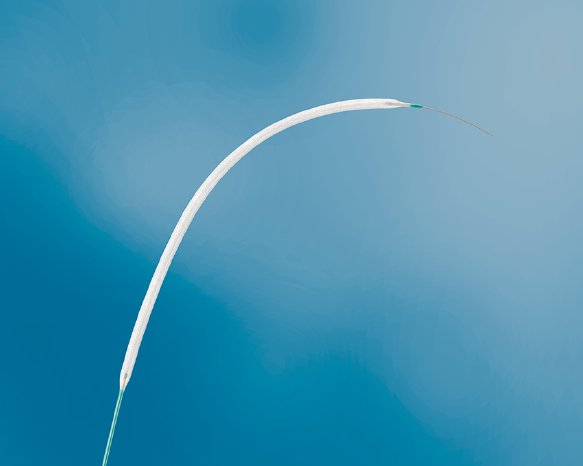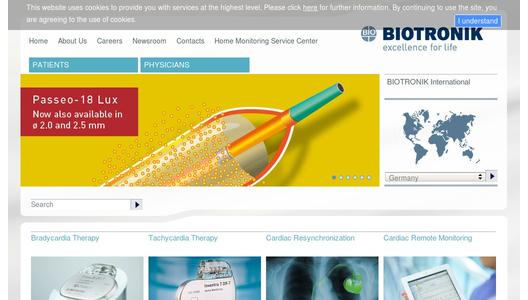“Passeo-18 Lux proved its safety in earlier randomized, controlled trials for both superficial femoral artery (SFA) and below-the-knee (BTK) indications1,2. As these trials served as proof of concept for the technology, the next step was to extend these results in a population reflecting routine clinical practice. BIOLUX P-III is therefore an all-comers registry enrolling a large number of real-world patients,” commented coordinating clinical investigator for the trial Dr. Gunnar Tepe, Rosenheim Clinic, Germany. “The results seen in the small cohort of patients from earlier trials are now strengthened by an interim analysis of 200 patients, offering further support for DCB as a potential standard approach for treating lower limb disease.”
BIOLUX P-III’s primary endpoint is freedom from major adverse events (MAE) at six months, defined as a composite of freedom from mortality, major target limb amputation and target lesion revascularization (TLR). Of the 200 patients for whom data is available so far, the rate of freedom from MAE was high at 94.4% while the rate of freedom from clinically driven TLR was 96.8%.
In addition to the data from BIOLUX P-III, new data on a novel combination therapy approach supporting Passeo-18 Lux DCB with Pulsar-18 self-expanding stent (SES) was presented. The BIOFLEX PEACE all-comers registry, studying the Pulsar SES, reported six-month interim results for 126 patients. 55 patients were treated with combination therapy (Pulsar-18 plus DCB) and demonstrated a Primary Patency (PP) rate of 89.1% and a freedom from TLR rate of 90.9%. Furthermore, the BIOLUX 4EVER clinical trial, which is currently evaluating the outcome of Passeo-18 Lux treatment followed by Pulsar-18 implementation in the SFA, was also presented. Interim six-month data on 85 patients demonstrated a PP rate of 96.1% and a freedom from TLR rate of 98.8%.
“Preliminary results from the ongoing BIOFLEX PEACE and BIOLUX 4EVER trials confirm the trend seen in the earlier DEBAS trial3. All of them show the high potential of combination therapy with Passeo-18 Lux and Pulsar-18 in the SFA,” stated the symposium’s chairperson Dr. Marianne Brodmann, Graz Medical University, Austria. “These preliminary results indicate that combination therapy supporting Passeo-18 Lux DCB with the thin-strut Pulsar-18 SES may improve the treatment outcomes of the two individual technologies in challenging vessel morphologies and patient populations.”
“Passeo-18 Lux and Pulsar-18, which is now also available in 2.0 and 2.5 mm diameters, represent key technologies in the BIOTRONIK peripheral portfolio, each bringing unique clinical benefits,” commented Dr. Alexander Uhl, BIOTRONIK Vice President Marketing, Vascular Intervention. “We stand by their clinical proof as individual treatment options, and with these additional studies we hope to extend the highly encouraging 24 month results from the DEBAS trial, demonstrating that combination therapy with both devices can achieve even better clinical performance.”
About Passeo-18 Lux
Passeo-18 Lux is a novel combination device for treating de novo and restenotic lesions in the infrainguinal arteries. Its design is based on that of the proven Passeo-18 uncoated balloon catheter, combined with a balloon coating containing a matrix of anti-proliferative paclitaxel and butyryl-tri-hexyl citrate, a biocompatible excipient to enable optimal drug transfer to the target lesion tissue. This coating is also applied to Pantera Lux, a clinically proven coronary drug-coated balloon. Passeo-18 Lux also features the unique SafeGuard insertion aid, which improves ease of handling and protects the user and balloon coating from contact and damage. After use, SafeGuard can simply be peeled away.
About Pulsar-18
Pulsar-18 stents feature an innovative, highly flexible design coated with proBIO, a silicon carbide layer that improves the stent's hemocompatibility and biocompatibility, which is believed to contribute to its excellent clinical results. Pulsar-18 is available in diameters of 4 to 7 mm, all deliverable through a 4 F sheath.
References:
1 Scheinert D, et al. J Endovasc Ther . 2015, 2(22)
2 Zeller T, et al. JACC Cardiovasc Interv. 2015, 8(12)
3 Mwipatayi P. Self-Expanding Thin Strut Nitinol Stents (Pulsar) Plus DEBs: 2-Year Results from The DEBAS Trial Are Promising. Presented at: Veith Symposium; November 19, 2015. ClinicalTrials.gov: NCT0187935
For more information, visit: www.biotronik.com


